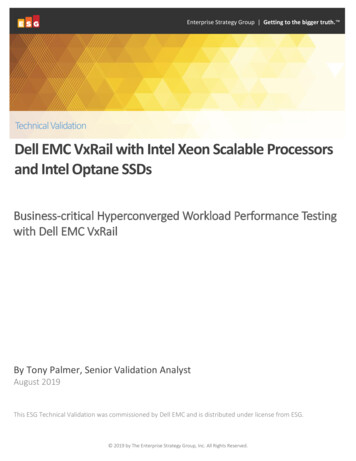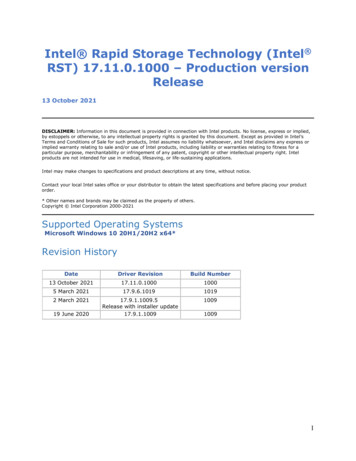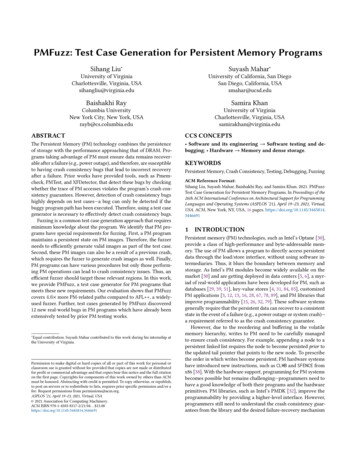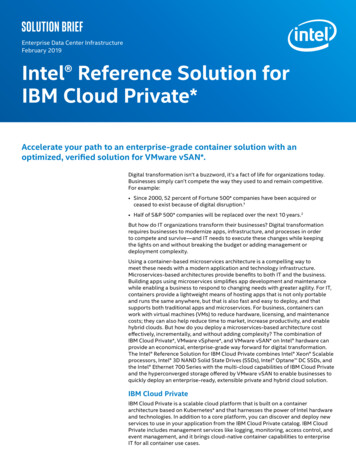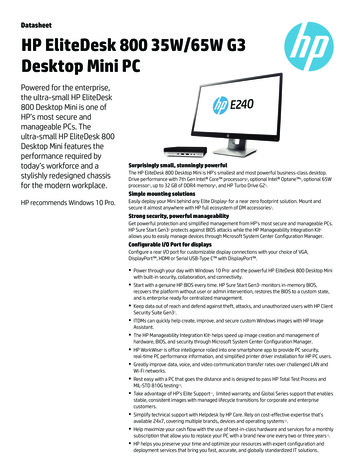
Transcription
Intel Optane persistent memory 200 series for HPE User GuidePart Number: 30-B41F6FB9-002Published: November 2021Edition: 2
Intel Optane persistent memory 200 series for HPE User GuideAbstractThis document includes installation, maintenance, and configuration information for the Intel Optane persistent memory 200 series for HPEand is for the person who installs, administers, and troubleshoots HPE ProLiant Gen10 Plus and HPE Synergy systems. Hewlett PackardEnterprise assumes you are qualified in the servicing of computer equipment and trained in recognizing hazards in products with hazardousenergy levels.Part Number: 30-B41F6FB9-002Published: November 2021Edition: 2 Copyright 2021 Hewlett Packard Enterprise Development LPNoticesThe information contained herein is subject to change without notice. The only warranties for Hewlett Packard Enterprise products andservices are set forth in the express warranty statements accompanying such products and services. Nothing herein should be construed asconstituting an additional warranty. Hewlett Packard Enterprise shall not be liable for technical or editorial errors or omissions containedherein.Confidential computer software. Valid license from Hewlett Packard Enterprise required for possession, use, or copying. Consistent with FAR12.211 and 12.212, Commercial Computer Software, Computer Software Documentation, and Technical Data for Commercial Items arelicensed to the U.S. Government under vendor's standard commercial license.Links to third-party websites take you outside the Hewlett Packard Enterprise website. Hewlett Packard Enterprise has no control over and isnot responsible for information outside the Hewlett Packard Enterprise website.AcknowledgmentsIntel , Optane , and Xeon , are trademarks of Intel Corporation in the U.S. and other countries.Linux is the registered trademark of Linus Torvalds in the U.S. and other countries.Red Hat Enterprise Linux is a registered trademark of Red Hat, Inc. in the United States and other countries.SUSE is a registered trademark of SUSE LLC in the United States and other countries.Windows Server is either registered trademarks or trademarks of Microsoft Corporation in the United States and/or other countries.VMWare vSphere is a registered trademark of VMware, Inc. in the United States and/or other jurisdictions.
Table of contents1 Introduction1.1 Intel Optane persistent memory 200 series for HPE1.1.1 Persistent memory modes1.1.2 Memory cache ratios2 Security features2.1 Passwords2.2 Encryption2.3 Sanitization2.4 Signed firmware2.5 Firmware rollback protection3 Component identification3.1 Intel Optane persistent memory 200 series for HPE label identification4 Installation4.1 System requirements4.2 Memory population information4.3 Persistent memory module handling guidelines4.4 Installing a DIMM or persistent memory module5 Configuring the system5.1 Configuration overview5.1.1 Configuration tools5.2 Setting the goal configuration5.2.1 Setting the goal configuration using UEFI System Utilities5.2.2 Setting the goal configuration with ipmctl5.2.3 Setting a goal configuration using HPE iLO RESTful API5.3 Creating namespaces5.3.1 Creating namespaces using UEFI System Utilities5.3.2 Creating namespaces using ipmctl5.3.3 Creating namespaces using ndctl in Linux5.4 Enabling key management5.4.1 Encrypting persistent memory modules with local key management5.4.2 Encrypting persistent memory modules with remote key management5.4.2.1 Using a key management server5.4.2.1.1 Supported key managers5.4.2.1.2 Configuring key manager servers5.4.2.1.2.1 Key manager server options5.4.2.1.3 Adding key manager configuration details5.4.2.1.3.1 Key manager configuration details5.4.2.1.4 Testing the key manager configuration5.4.2.1.5 Viewing key manager events5.4.2.1.6 Clearing the key manager log5.5 Other BIOS/Platform Configuration (RBSU) options6 Management tools
6.1 Managing Intel Optane persistent memory for HPE6.2 UEFI System Utilities6.2.1 Changing the goal configuration using UEFI System Utilities6.2.2 Deleting the goal configuration using UEFI System Utilities6.2.3 Changing persistent memory module passwords6.2.4 Viewing the status of persistent memory modules6.2.5 Changing the key management mode6.2.6 Disabling key management6.2.7 Disabling encryption for a persistent memory module6.2.8 Changing Performance Options using UEFI System Utilities6.3 HPE iLO RESTful API6.3.1 HPE iLO RESTful API overview6.3.1.1 Data model overview6.3.1.1.1 Examples: Retrieving memory resources6.3.2 Managing Intel Optane persistent memory for HPE with the HPE iLO RESTful API6.3.3 Persistent memory module provisioning with the HPE iLO RESTful API6.3.4 Examples: Provisioning persistent memory modules6.3.4.1 Using RESTful Interface Tool rawpost to configure 100% App Direct interleaved6.3.4.2 Using python to configure 100% App Direct interleaved6.3.4.3 Using Postman to configure 100% App Direct interleaved6.3.5 Example: Managing Intel Optane persistent memory for HPE using curl6.4 RESTful Interface Tool6.4.1 Launching the RESTful Interface Tool6.4.2 Discovery commands6.4.2.1 Device discovery6.4.2.2 Device configuration discovery6.4.2.3 Persistent interleave regions discovery6.4.2.4 Persistent memory summary6.4.3 Configuration commands6.4.3.1 Show pending configuration6.4.3.2 Apply predefined configuration6.4.3.3 Apply a user-defined configuration6.4.3.4 Clear pending configuration6.4.3.5 Show recommended configuration6.5 ipmctl tool6.5.1 Installing ipmctl for Linux6.5.2 Showing persistent memory module configurations with ipmctl6.5.3 Deleting a goal configuration with ipmctl6.5.4 Deleting namespace with ipmctl6.5.5 Determining the memory mode with ipmctl7 Maintenance7.1 Persistent memory module relocation guidelines7.2 Manually backing up persistent memory module data
7.3 Removing a DIMM or persistent memory module7.4 Replacing a system board7.5 Migrating a persistent memory module7.5.1 Migrating a persistent memory module encrypted with local key management7.5.2 Migrating a persistent memory module encrypted with remote key management7.6 Sanitizing a persistent memory module7.6.1 Sanitization policies7.6.2 Sanitization guidelines7.6.3 Sanitization with UEFI System Utilities7.6.4 Sanitization with the HPE iLO RESTful API7.6.5 Sanitization with ipmctl7.7 Recommissioning a persistent memory module with a lost password7.8 Updating persistent memory module firmware8 Linux support of Intel Optane persistent memory 200 series for HPE8.1 nmem devices8.1.1 nmem device properties8.1.2 Listing nmem devices8.2 Regions8.2.1 Region properties8.2.2 Listing regions8.3 Namespaces8.3.1 Namespace properties8.3.2 Creating a namespace8.3.3 List all namespaces8.3.4 Changing namespace mode8.3.5 Deleting namespaces8.4 Initialization of pmem devices8.5 Showing the amount of memory in the system8.6 Filesystems8.7 I/O statistics9 VMware support of Intel Optane persistent memory 200 series for HPE10 Windows Server support of Intel Optane persistent memory 200 series for HPE11 Troubleshooting11.1 Known issues11.1.1 System boot fails due to persistent memory file systems11.2 Troubleshooting resources12 Websites13 Support and other resources13.1 Accessing Hewlett Packard Enterprise Support13.2 Accessing updates13.3 Remote support13.4 Warranty information13.5 Regulatory information13.6 Documentation feedback
IntroductionIntroduction7
Intel Optane persistent memory 200 series for HPEIntel Optane persistent memory 200 series for HPE offers the flexibility to deploy memory as dense memory (Memory mode) or faststorage (App Direct mode) and enables per-socket memory capacity of up to 4.0 TB. Persistent memory modules, together withtraditional volatile DRAM DIMMs, provide fast, high-capacity, cost-effective memory and storage to transform big data workloads andanalytics by enabling data to be stored, moved, and processed quickly.Persistent memory modules use the standard DIMM form factor and are installed alongside DIMMs in a server memory slot. Intel Optanepersistent memory 200 series for HPE is designed for use only with third-generation Intel Xeon Scalable processors, and is available inthe following capacities:128 GB256 GB512 GBIntel Optane persistent memory 200 series for HPE8
Persistent memory modesIntel Optane persistent memory 200 series for HPE can be configured to operate in two modes.App Direct modeWhen configured for App Direct mode, persistent memory modules function as persistent memory.Memory modeWhen configured for Memory mode, persistent memory modules function as volatile system memory while DRAM capacity operates as acache. For more information, see Memory cache ratios.Persistent memory modes9
Memory cache ratiosPersistent memory modules can be carved into volatile and persistent regions.For the volatile region, the ratio of volatile memory capacity to DRAM capacity affects performance. The recommended volatile memorycapacity to DRAM capacity is between 4:1 and 16:1:4:1—largest cache; most likely to get cache hits.8:116:1—smallest cache; least likely to get cache hits.Users are strongly recommended not to configure for Memory Mode when the ratio is at 1:1 or lower due to more severe performanceimpact.A message will be logged to the Integrated Management Log (IML) if a cache ratio that is not recommended is used.The following table contains example configurations, with 100% of the persistent memory module capacity allocated to volatile memory.Cache ratios improve as some of that memory is carved into persistent memory.Persistent memorymodule capacity 1Persistent memorymodule configurationDIMM capacity 1DIMM configurationRatio1024 GB8 x 128 GB128 GiB8 x 16 GiB8:1256 GiB8 x 32 GiB4:1512 GiB8 x 64 GiB2:1 21024 GiB8 x 128 GiB1:1 2128 GiB8 x 16 GiB16:1256 GiB8 x 32 GiB8:1512 GiB8 x 64 GiB4:11024 GiB8 x 128 GiB2:1 22048 GiB8 x 256 GiB1:1 2128 GiB8 x 16 GiB32:1 3256 GiB8 x 32 GiB16:1512 GiB8 x 64 GiB8:11024 GiB8 x 128 GiB4:12048 GiB8 x 256 GiB2:1 22.0 TB4.0 TB8 x 256 GB8 x 512 GB1 Capacity per processor.2Not recommended. No benefit from caching.3 Not recommended.Memory cache ratios10
Security featuresIntel Optane persistent memory for HPE provides a number of features to secure and protect your data:PasswordsEncryptionSanitizationSigned firmwareFirmware rollback protectionSecurity features11
PasswordsPersistent memory modules support password-based locking with a 32 byte binary password. If locked, data on the persistent memorymodule is not accessible until it is unlocked. If a persistent memory module is locked and the password is lost, the persistent memorymodule can be sanitized to regain access to the hardware, but it does not provide access to the data.HPE ProLiant and HPE Synergy Gen10 Plus server products provide two methods for managing persistent memory module passwords:Local key managementRemote key managementOnly one key management method can be selected at one time to manage passwords.Local key managementLocal key management is available in servers with HPE Trusted Platform Module (TPM) 2.0 installed. When enabled, the servergenerates a 32 byte random value to use as a password for each persistent memory module.Persistent memory module passwords are stored in a flash memory shared by HPE iLO and the system firmware. Each password in thepassword database is encrypted using the HPE TPM 2.0, a tamper resistant part.During POST, the server extracts the passwords from the database and unlocks all persistent memory modules. Passwords can beexported to a USB key for migration into another server. This migration file is encrypted with a key generated from a transientpassword (an ASCII string) that the user must provide. To import the file on another server, the user must enter the same transientpassword.This file also serves as a backup to restore the passwords if the server system board fails.Remote key managementRemote key management is available in servers with the HPE iLO enrolled in and connected to a key management server. Persistentmemory module passwords are automatically generated, managed, and stored on a key management server. The remote keymanagement feature requires an HPE iLO Advanced License.Passwords12
EncryptionPersistent memory modules encrypt all data written to the media using 256 bits XTS-AES algorithms.For volatile memory regions, the persistent memory module generates a new encryption key at power-up and holds the key in a volatileregister, which is lost on power loss. Although the media is naturally persistent, it makes the volatile memory region effectively volatile.For persistent memory regions, the persistent memory module remembers the encryption key across power cycles, ensuring that thedata is still accessible.If the persistent memory module password is enabled, the encryption key is itself encrypted by another key derived from thepassword. This "key wrapping" prevents an unauthorized user from reading the media content.The encryption key is available only if the proper password is presented to the persistent memory module, and the persistentmemory module holds it in volatile registers.If the persistent memory module password is not enabled, the encryption key is stored on the media. Although the user data isencrypted, an unauthorized user might be able to decrypt it.Both cases facilitate an "instant secure erase" sanitization feature. By changing the encryption key, all data becomes undecipherable.With a persistent memory module password, the encryption key is never exposed. Without a password, the encryption key is neverexposed to the system, but an unauthorized user with physical access to the medium might have retrieved the encryption key beforeerase and used it later. That tampering would be physically evident.Encryption13
SanitizationMedia sanitization is defined by NIST SP800-88 Guidelines for Media Sanitization (Rev 1, Dec 2014) as "a general term referring to theactions taken to render data written on media unrecoverable by both ordinary and extraordinary means."The specification defines the following levels:Clear: Overwrite user-addressable storage space using standard write commands; might not sanitize data in areas not currentlyuser-addressable (such as bad blocks and over-provisioned areas).Purge: Overwrite or erase all storage space that might have been used to store data using dedicated device sanitize commands,such that data retrieval is "infeasible using state-of-the-art laboratory techniques."Destroy: Ensure that data retrieval is "infeasible using state-of-the-art laboratory techniques" and render the media unable to storedata (such as disintegrate, pulverize, melt, incinerate, or shred).Intel Optane persistent memory for HPE supports the purge level using a cryptographic erase technique and an overwrite technique.HPE ProLiant and HPE Synergy Gen10 Plus server products support sanitizing persistent memory modules during POST. Use theRESTful Interface Tool or UEFI System Utilities to schedule sanitization on the next boot.Cryptographic erase techniqueThis technique allows "instant secure erase," scrambling all persistent contents on the persistent memory module in less than a second,no matter what the capacity. Persistent media reads back random-looking data (data encrypted with a now-lost key).It also ensures that data in bad or worn-out parts of the media is undecipherable, even if these areas could be accessed. This techniqueis stronger than overwrite techniques, which might be unable to overwrite such areas.Sanitization is allowed under this technique, even if the persistent memory module is locked with a password. This ensures that thepersistent memory module hardware is usable even if you forget the password.Overwrite techniquePersistent memory modules also support an overwrite technique. It complies with the clear level by default, but it also complies with thepurge level if it is successful at overwriting bad and worn-out parts of the media.If encryption is enabled (a password has been set on the persistent memory module), this operation overwrites the media withencrypted zeroes. If encryption is not enabled or if the CryptoEraseOverwrite command is used, the operation overwrites themedia with zeroes.NIST SP800-88 Guidelines for Media Sanitization (Rev 1, Dec 2014) is available for download from the NIST blications/NIST.SP.800-88r1.pdf).Sanitization14
Signed firmwarePersistent memory module firmware images are cryptographically signed. The image includes a cryptographic hash value (for example,SHA-256) that is encrypted using RSA public-private key encryption.The hash value is encrypted using the private key. The persistent memory module decrypts the hash value using the public key.The private key is kept in a FIPS 140-2 level 3 or level 4 (tamper-resistant or tamper-proof) code-signing appliance. The applianceenforces access controls so that it only accepts authentic, signed images. The persistent memory module rejects images that do notdecrypt correctly.Signed firmware15
Firmware rollback protectionFirmware images are identified by version number, similar to 01.02.03.0405.The second field (for example, 02) represents the security version number. This number is incremented in releases that contain securityimprovements. Persistent memory modules cannot accept firmware images with an older security version number than the image thatis running. This protection prevents the firmware from rolling back to an earlier image that might contain exploitable features. Firmwareroll-back can only be done with individual binary files via BIOS embedded FW update applications.Firmware rollback protection16
Component identificationComponent identification17
Intel Optane persistent memory 200 series for HPE label identificationItemDescriptionExample1Work Order NumberXXXXXXX2Work Order Number BarcodeXXXXXXX3Capacity128 GB256 GB512 GB4Unique ID number8089-A2-1802-1234567A5Serial Number and PartNumber BarcodeS8089A218040000168APNMAXXXXXXXXXXX6Product NameIntel Optane persistent memory7Part Number1234567A8Serial Number Barcode8089-A2-1802-1234567A9PBA NumberXXXXXX-XXXFor more information about product features, specifications, options, configurations, and compatibility, see the product QuickSpecs onthe Hewlett Packard Enterprise website ntel Optane persistent memory 200 series for HPE label identification18
InstallationInstallation19
System requirementsIMPORTANT:Hewlett Packard Enterprise recommends that you implement best-practice configurations such as clusteredconfigurations for high availability (HA).The following hardware components are required:HPE DDR4 Standard Memory RDIMMs or LRDIMMsIntel Optane persistent memory 200 series for HPEThird-generation Intel Xeon Scalable processorsSupported firmware versions:System ROM version 1.40 or laterServer Platform Services (SPS) Firmware version 04.04.04.053HPE iLO 5 Firmware version 2.44HPE Innovation Engine Firmware version 1.0.0.20 or laterDownload the required firmware and drivers from the Hewlett Packard Enterprise .Supported operating systems:Windows Server 2016 with persistent memory drivers from Hewlett Packard EnterpriseWindows Server 2019Red Hat Enterprise Linux 7.9 and laterRed Hat Enterprise Linux 8.2 and laterSUSE Linux Enterprise Server 12 SP5 and laterSUSE Linux Enterprise Server 15 SP2 and laterVMware vSphere 7.0 U2 and laterVMware vSphere 6.7 U3 with P03Hardware and licensing requirements for optional encryption of the persistent memory modules:HPE TPM 2.0 (local key encryption)HPE iLO Advanced License (remote key encryption)Key management server (remote key encryption)System requirements20
Memory population informationDIMMs and persistent memory modules are installed in specific configurations based on the workload requirements of the server.Supported configurations are optimized for persistent memory capacity, volatile memory capacity, and performance.Persistent memory capacity—the available capacity is equal to the persistent memory module capacity.Volatile memory capacity:App Direct mode—the volatile capacity is equal to the DRAM capacity (the capacity of all the non- persistent memory modulesinstalled).Memory tier capacity—the memory tier capacity is the total capacity of all installed memory (DRAM and persistent memorymodules).IMPORTANT:If the installed memory exceeds the processor capacity, the system will map out all but one DIMM channel andoperate in App Direct mode. A message will be logged to the IML for exceeding capacity. To resolve the issue,remove the memory that exceeds the processor capacity.Performance:Uses all channels to efficiently utilize processor resources.Memory mode—more regular DIMMs provide a better cache ratio.Before beginning the installation, review the memory population guidelines on the Hewlett Packard Enterprise website .Memory population information21
Persistent memory module handling guidelinesCAUTION:Failure to properly handle persistent memory modules can damage the component and the system board connector.When handling a persistent memory module, observe the following guidelines:Avoid electrostatic discharge.Always hold persistent memory modules by the side edges only.Avoid touching the connectors on the bottom of the persistent memory module.Never wrap your fingers around a persistent memory module.Avoid touching the components on the sides of the persistent memory module.Never bend or flex the persistent memory module.When installing a persistent memory module, observe the following guidelines:Before seating the persistent memory module, open the persistent memory module slot and align the persistent memory modulewith the slot.To align and seat the persistent memory module, use two fingers to hold the persistent memory module along the side edges.To seat the persistent memory module, use two fingers to apply gentle pressure along the top of the persistent memory module.For more information, see the Hewlett Packard Enterprise website sistent memory module handling guidelines22
Installing a DIMM or persistent memory moduleFor server-specific steps used in this procedure, see the server user guide on the Hewlett Packard Enterprise website:HPE ProLiant Gen10 Plus servers ( E Synergy Gen10 Plus compute modules ( wlett Packard Enterprise recommends that you implement best-practice configurations such as clusteredconfigurations for high availability (HA).PrerequisitesBefore beginning the installation, review the memory population guidelines on the Hewlett Packard Enterprise website .Procedure1. Observe the following alerts:CAUTION:DIMMs and persistent memory modules are keyed for proper alignment. Align notches on the DIMM or persistentmemory module with the corresponding notches in the slot before installing the component. Do not force the DIMMor persistent memory module into the slot. When installed properly, not all DIMMs or persistent memory moduleswill face in the same direction.CAUTION:Electrostatic discharge can damage electronic components. Be sure you are properly grounded before beginningthis procedure.CAUTION:Failure to properly handle persistent memory modules can damage the component and the system board connector.2. Power down the server:a. Shut down the OS as directed by the OS documentation.b. To place the server in standby mode, press the Power On/Standby button. When the server enters standby power mode, thesystem power LED changes to amber.c. Disconnect the power cords (rack and tower servers).3. Do one of the following:Extend the server from the rack.Remove the server from the rack, if necessary.Remove the server or server blade from the enclosure.4. Place the server on a flat, level work surface.5. Remove the access panel.6. Remove all components necessary to access the DIMM slots.7. Install the DIMM or persistent memory module.Installing a DIMM or persistent memory module23
8. Install any components removed to access the DIMM slots.9. Install the access panel.10. Slide or install the server into the rack.11. If removed, reconnect all power cables.12. Power up the server.Installing a DIMM or persistent memory module24
Configuring the systemConfiguring the system25
Configuration overviewConfigure Intel Optane persistent memory for HPE by:1. Setting a "goal configuration," which defines the regions of volatile memory and persistent memory on a persistent memory module.2. Creating namespaces on top of the resulting persistent regions.3. (Optional) Enabling local or remote key management.4. (Optional) Encrypting the persistent memory modules.IMPORTANT:Always follow recommendations from your software application provider for high-availability best practices to ensuremaximum uptime and data protection.Configuration overview26
Configuration toolsA number of tools are available to configure and maintain Intel Optane persistent memory for HPE:Embedded toolsUEFI System Utilitiesipmctl tool (under the UEFI Shell)REST/iLO-based toolsHPE iLO RESTful APIRESTful Interface ToolOS-based toolsWindows PowerShell cmdletsipmctl tool (Linux and Windows)ndctl tool (Linux)Configuration tools27
Setting the goal configurationGoal configurations that define regions of volatile memory and persistent memory are stored in the metadata of the persistent memorymodules. Because persistent memory modules are on the system memory bus, changing the goal configuration requires a systemreboot. During the next boot, system firmware detects the goal configuration request and reconfigures the persistent memory modules.Goal configurations must adhere to the recommended memory cache ratios. Selecting a non-recommended ratio will generate messagesin the IML.IMPORTANT:When data must be preserved, Hewlett Packard Enterprise strongly recommends that you perform a manual backup ofall user data on the persistent memory modules before changing the goal configuration or performing relocationprocedures.IMPORTANT:Always follow recommendations from your software application provider for high-availability best practices to ensuremaximum uptime and data protection.Setting the goal configuration28
Setting the goal configuration using UEFI System UtilitiesIMPORTANT:Be sure to observe all pop-up messages displayed in UEFI System Utilities that pertain to persistent memory. Failure tofollow the instructions in these messages might cause persistent memory data loss.Procedure1. From the System Utilities screen, select System Configuration BIOS/Platform Configuration (RBSU) Memory Options.2. Confirm the following default settings:Maximum Memory Bus Frequency —AutoMemory Patrol Scrubbing —EnabledMemory Remap—No Action3. Select Persistent Memory Options, and confirm the following selection:Persistent Memory Address Range Scrub —Enabled.4. Select PMM Options Goal Configuration Options .Goal Configuration Options displays the most recent configuration settings, but not necessarily the active configuration. Theconfiguration settings defined in this screen are only applied at the next server reboot.5. Make the following selections:Volatile Memory Capacity —% of persistent memory module capacity providing volatile memory:Memory mode—Select 100%.App Direct mode—Select 0%.Persistent Memory Interleaving —Enabled or Disabled.6. Select Apply Goal Configuration .Goal configuration settings will be applied at the next reboot.7. Select PMM Options Security Options Security Freeze Lock —Disabled.8. Confirm your selections.9. To save your changes, press the F12 key.10. To commit the goal configuration and persistent memory options, reboot the server.Setting the goal configuration using UEFI System Utilities29
Setting the goal configuration with ipmctlThe ipmctl tool can be run in the UEFI command line, Windows OS, or in Linux:create[-dimm [(DimmIDs)]]-goal[-socket (SocketIDs)][MemoryMode (0 %)][PersistentMemoryType (AppDirect AppDirectNotInterleaved)]Sample goal configurationsCommandDescriptionipmctl create -goalDefaults to 100% interleaved persistentmemoryipmctl create -goal MemoryMode 0 Reserved 100100% unconfiguredipmctl create -goal MemoryMode 100100% volatile memoryipmctl create -goal MemoryMode 0 PersistentMemoryType A 100% interleaved persistent memoryppDirectipmctl create -goal MemoryMode 0 PersistentMemoryType A 100% non-interleaved persistent memoryppDirectNotInterleavedipmctl create -goal MemoryMode 80 PersistentMemoryType AppDirect80% volatile memory20% interleaved persistent memoryThe values must adhere to the recommended memory cache ratio. Selecting a nonrecommended ratio might impact system performanceand will generate messages in the IML.Setting the goal configuration with ipmctl30
Setting a goal configuration using HPE iLO RESTful APIThe HPE iLO RESTful API can be accessed using a number of tools. Hewlett Packard Enterprise recommends using the RESTfulInterface Tool.The rawpost command takes in a JSON file. The following example displays the JSON file and a batch script to use the RESTfulInterface Tool to configure a server for 100% AppDirect with interleaving enabled.Memorychunk-rawpost.txt{"path": main/MemoryChunks","body": {"AddressRangeType": "PMEM","Oem": {"Hpe": {"MemoryChunkSizePercentage": 100}},"InterleaveSets": [{"Memory": {"@odata.id": "/redfish/v1/Systems/1/Memory/proc1dimm6/"}}, {"Memory": {"@odata.id": dows batch script@echo offset argC 0for %%x in (%*) do Set /A argC 1if %argC% LSS 3 goto :failConditiongoto :main:failCondition@echo Usage:@echo ilorest-script-memory-remote.bat [URL] [USERNAME] [PASSWORD]goto :EOF:main@echo Logging in.
7.7 Recommissioning a persistent memory module with a lost password 7.8 Updating persistent memory module firmware 8 Linux support of Intel Optane persistent memory 200 series for HPE 8.1 nmem devices 8.1.1 nmem device properties 8.1.2 Listing nmem devices 8.2 Regions 8.2.1 Region properties 8.2.2 Listing regions 8.3 Namespaces 8.3.1 Namespace .
